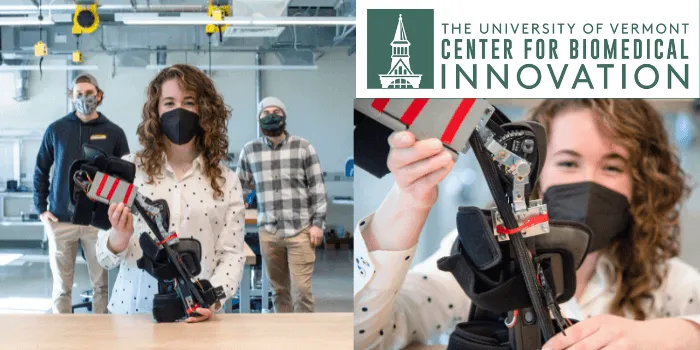In a world that is growing ever more complex, the most effective solutions require a holistic understanding of the issues at hand — and for experts in different specialties to work in tandem.
It’s this understanding that serves as the foundation for UVM’s Center for Biomedical Innovation and the creative environment it fosters. At the CBI, faculty and students from the College of Engineering and Mathematical Sciences, the Larner College of Medicine, the College of Nursing and Health Sciences and the Grossman School of Business collaborate on designing, building and marketing innovative devices, systems and software that promote human health.
Early last semester the CBI hosted its fourth innovation workshop. Members of the community came together with UVM faculty and students to share innovative ideas for improving health care around the state — particularly in rural areas.
The CBI has already given birth to a number of unique medical products. For example, a device developed by the group can quickly measure the right dose of epinephrine — based on weight — for children experiencing cardiac arrest, a life-saving tool for understaffed rural health care facilities.
In addition to serving as an incubator for important new technologies, the CBI is also an essential part of students’ educational experience. But how to create — out of thin air — a steady stream of meaty medical device ideas for students and their faculty mentors to work on?
Design Populism
UVM arrived at what Mike Rosen, interim director of the center, calls a “populist” approach. Every few months, the CBI holds events that are part workshop-part pitch, where participants nominate their ideas, a few of which are refined during the event and subsequently reviewed in detail by a CBI committee for selection to move forward with CBI support.
In the workshop held last semester, held pandemic-style via Microsoft Teams, about 40 participants and spectators hovered in front of their computer screens. Nine teams presented their ideas, while a mix of faculty, staff, students and community members observed.
For Rosen and the event’s other two adjudicators — Erik Monsen, the Steven Grossman Endowed Chair in Entrepreneurship in the Grossman School of Business, and Raj Aurora, a third-year medical student at the Larner College of Medicine — two stood out and will become official CBI projects.
Nicole Donahue, an accelerated master’s degree student in Electrical and Biomedical Engineering, and Tori Weissman, a senior Biomedical Engineering major, presented a device called an Instrumented Knee Brace for Remote Tracking of ACL Surgery Recovery, initially developed by CEMS faculty member and biomedical engineer Ryan McGinnis and post-doctoral associate Reed Gurchiek.
The brace is packed with sensors and an on-board micro-computer that detect post ACL-surgery gait irregularities, which can cause knee arthritis if not corrected, as patients traverse the real world. It promises to deliver much more accurate information than current sampling methods, where gait data is collected while patients walk in a lab.
Also wowing the crowd was the Recovery Robe, a vast improvement over the scant, impossible-to-tie garment patients struggle with in doctors’ waiting rooms and hospitals.
First developed by a team of medical and engineering students in UVM’s Design for America chapter and presented by senior Mechanical Engineering major Ross Elkort, the garment is a tour de force of design, allowing patients to cover themselves easily and securely, while providing health professionals full access to the patient’s body without unnecessary exposure. The robe also keeps IV lines in place as it is put on and taken off. Both ideas will evolve from rough prototypes to more finished products in the CBI.
Two-in-one
The CBI is meant to serve two distinct purposes, said CEMS Dean Linda Schadler in remarks at the opening of the workshop: to educate students about biomedical engineering design and the importance of working in teams to find technical solutions to health care needs, and to bring together experts in complementary disciplines to solve important problems.
“Our students benefit from working in interdisciplinary teams that allow them to apply what they are learning in the classroom,” she said. “And the community benefits from engineers and business faculty supporting the technical needs and innovation of the faculty in medicine and nursing.” Those solutions, ideally, will also have practical business applications, Schadler said, strong possibilities for both the knee brace and the Recovery Robe, according to Rosen.
Four years
Education is also on the minds of McGinnis, who co-developed a new curriculum for the Biomedical Engineering major that was implemented this year, and Rosen, who is developing a plan for how CBI experiences will be infused into that curriculum. The big idea: Design won’t be left to the tail end of the program, McGinnis says, but will be part of a continuum, covering all four years of the new project-based curriculum and culminating in a capstone design project in the CBI. “This truly sets our program apart,” he says, “and will set our graduates apart for prospective employers and graduate schools.”
The CBI’s educational benefits, while particularly relevant for BME majors, extend to reach medical, nursing, health sciences and business students, as well as those in other engineering disciplines, all of whom are active in the center. Some students work in the CBI, recruited by Rosen based on the expertise they can offer, and receive course credit or are paid a stipend.
“It’s like doing research in a faculty member’s lab,” says Rosen. “It’s hands-on, project-based learning in design. With a CBI project, students know they’re not just doing another homework assignment; people in Vermont and elsewhere may benefit directly from their work and inventiveness.”
A compelling way to learn, one that confers a highly marketable skill, and a pathway that could lead to an array of innovative new ways to improve human health.
